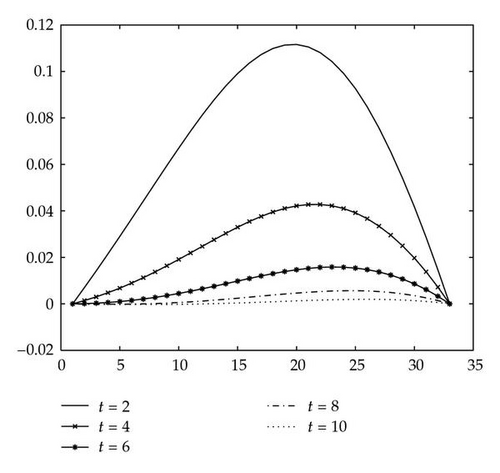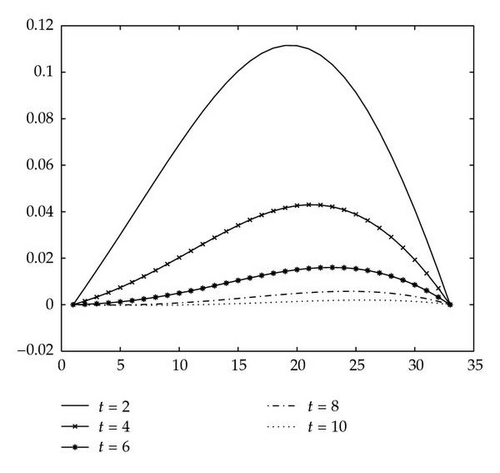Numerical Analysis of a Linear-Implicit Average Scheme for Generalized Benjamin-Bona-Mahony-Burgers Equation
Abstract
A linear-implicit finite difference scheme is given for the initial-boundary problem of GBBM-Burgers equation, which is convergent and unconditionally stable. The unique solvability of numerical solutions is shown. A priori estimate and second-order convergence of the finite difference approximate solution are discussed using energy method. Numerical results demonstrate that the scheme is efficient and accurate.
1. Introduction
In recent years, a vast amount of work and computation has been devoted to the initial value problem for the GBBM-Burgers equation. In [1], Al-Khaled et al. studied the GBBM-Burgers by Decomposition method. In [8], Hayashi et al. investigated large time asymptotics of solutions to the BBM-Burgers equation. In [9], Jiang and Xu investigated the asymptotic behavior of solutions of the initial-boundary value problem for the GBBM-Burgers equations. In [10], Yin et al. studied the large time behavior of traveling wave solutions to the Cauchy problem of the GBBM-Burgers equations. In [11], Mei studied the large time behavior of global solutions to the Cauchy problem of GBBM-Burgers equations. In [12], Kondo and Webler studied the global existence of solutions for multidimensional GBBM-Burgers equations. Kinami et al. discussed the Cauchy problem of the GBBM-Burgers equations by Fourier transform method and energy method [13]. However, there are few studies on finite difference approximations for (1.1) which we consider in this paper.
In a recent work [14], we have made some preliminary computation by proposing a linearized difference scheme for GRLW equation which is unconditionally stable and reduces the computational work, and the numerical results are encouraging. In this paper, we continue our work and propose a linear-implicit difference scheme for generalized BBM-Burgers equation which is unconditionally stable and second-order convergent.
2. Finite Difference Scheme and Estimate for the Difference Solution
Lemma 2.1 (see [15].)For any two mesh functions , one has
Lemma 2.2. For any mesh function , one has
Proof. For , one has
Lemma 2.3 (Discrete Sobolev Inequality [16]). For any discrete function uh and for any given ε > 0, there exists a constant K(ε, n), depending only ε and n, such that
Theorem 2.4. Assume , then there is the estimation for the solution of difference scheme (2.3)–(2.6),
Proof. Computing the inner product of (2.3) with (i.e., un+1 + un−1), we obtain
3. Solvability
Next, we will discuss the solvability of the scheme (2.3) based on the technique of Omrani et al. [17].
Theorem 3.1. The finite difference scheme (2.3) is uniquely solvable.
Proof. It is obvious that u0 and u1 are uniquely determined by (2.4)-(2.5). Now suppose u0, u1, … , un (1 ≤ n ≤ N − 1) be solved uniquely. Considering the equation of (2.3) for un+1, we have
In view of difference properties and the boundary conditions (2.6), we obtain
Remark 3.2. All results above in this paper are correct for IBV problem of the BBM-Burgers equation with finite or infinite boundary.
4. Convergence and Stability of the Difference Scheme
First, we consider the truncation error of the difference scheme (2.3)–(2.6).
Lemma 4.1. Assume u(x, t) is smooth enough, then the local truncation error of the finite difference scheme (2.3)–(2.6) is
Lemma 4.2 (see [16].)Suppose that the discrete function wh satisfies recurrence formula
Theorem 4.3. Assume and u ∈ C(4,3), then the solution of the difference scheme (2.3)–(2.6) converges to the solution of the problem (1.3) with order O(h2 + τ2) by the ||·||∞ norm.
Proof. Let . Subtracting (2.3)-(2.5) from (4.1)–(4.3), respectively, we have
Similarly, the following theorem can be proved.
5. Numerical Experiments
In this section, we will compute several numerical experiments to verify the correction of our theoretical analysis in the above sections.
Example 5.1 (see [20].)Consider the following initial-boundary problem of BBM-Burgers equation:
| h = 1/4 | h = 1/8 | h = 1/16 | h = 1/32 | |
|---|---|---|---|---|
| Scheme I | 2.486233e − 4 | 6.519728e − 5 | 1.618990e − 5 | 4.929413e − 6 |
| Scheme II | 2.438693e − 4 | 6.418263e − 5 | 1.594145e − 5 | 3.867502e − 6 |
Example 5.2 (see [13].)Consider the GBBM-Burgers equation
Figures 1 and 2 plot the numerical solutions computed by the linearly implicit scheme (2.3) with τ = 0.1, h = 0.03125, and α = 0.5 when p = 2, 8 at t = 2,4, 6,8, and 10, respectively. From Figures 1 and 2, it is easy to observe that the height of the numerical approximation to u is more and more low with time elapsing due to the effect of dissipative term αuxx. Both of them simulates that the continuous energy E(t) of the problem (1.3) in Theorem 2.4 decreases in time. Numerical experiments show our scheme is accurate and efficient.
| h = 1/4 | h = 1/8 | h = 1/16 | h = 1/32 | |
|---|---|---|---|---|
| Scheme II | 5.293584e − 4 | 1.416254e − 4 | 3.480022e − 5 | 8.423768e − 6 |
| Scheme III | 5.069513e − 3 | 3.444478e − 3 | 1.916013e − 3 | 9.262223e − 4 |
| h | | | vn − un|| | | | vn − un | |∞ | | | vn/4 − un/4||/| | vn − un|| | | | vn/4 − un/4 | |∞/| | vn − un | |∞ |
|---|---|---|---|---|
| 0.25 | 6.377969e − 4 | 9.352639e − 4 | — | — |
| 0.125 | 1.582597e − 4 | 2.314686e − 4 | 4.030065 | 4.040566 |
| 0.0625 | 3.920742e − 5 | 5.893641e − 5 | 4.036473 | 3.927429 |
| 0.03125 | 9.501117e − 6 | 1.428261e − 5 | 4.126612 | 4.126445 |
| h | | | vn − un|| | | | vn − un | |∞ | | | vn/4 − un/4||/| | vn − un|| | | | vn/4 − un/4 | |∞/| | vn − un | |∞ |
|---|---|---|---|---|
| 0.25 | 6.316492e − 4 | 9.262624e − 4 | — | — |
| 0.125 | 1.568213e − 4 | 2.294480e − 4 | 4.027828 | 4.036916 |
| 0.0625 | 3.885715e − 5 | 5.828155e − 5 | 4.035841 | 3.936889 |
| 0.03125 | 9.416614e − 6 | 1.412454e − 5 | 4.126446 | 4.126262 |
| h | | | vn − un|| | | | vn − un | |∞ | | | vn/4 − un/4||/| | vn − un|| | | | vn/4 − un/4 | |∞/| | vn − un | |∞ |
|---|---|---|---|---|
| 0.25 | 1.150448e − 4 | 1.822979e − 4 | — | — |
| 0.125 | 2.981547e − 5 | 4.674950e − 5 | 3.858561 | 3.899462 |
| 0.0625 | 7.426232e − 6 | 1.167644e − 5 | 4.014885 | 4.003745 |
| 0.03125 | 1.801424e − 6 | 2.879611e − 6 | 4.122423 | 4.054867 |


6. Conclusions
In this paper, we have presented a three-level linear-implicit finite difference scheme for the GBBM-Burgers equation, which has a wide range of applications in physics. The convergence and stability as well as second-order error estimate of the finite difference approximate solutions were discussed in detail. Numerical experiments show our scheme is accurate and efficient.
Acknowledgments
This work is supported by the fund of National Natural Science (11171193, 11171180, and 10901096) and the fund of Natural Science of Shandong Province (ZR2009AL019, ZR2011AM016), and the Youth Research Foundation of WFU (no. 2011Z17). The authors thank the referees for their valuable comments.




